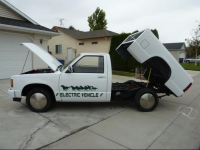I recall reading about how youtuber "Rich Rebuilds" took the 102V drivetrain from a wrecked Zero motorcycle, and adapted it to a light vintage hot rod with a 3-speed manual transmission.
He ended up using only two of the gears, but he reported that acceleration was very nice (and certainly "useable"). The video seems to verify it ran well.
Tesla gets great performance from one speed because it uses super high watts, but I wouldn't need high performance.
My theoretical proposal would be a small truck like a Chevy S-10, with a manual transmission. These have been converted before, so that's no problem, with many examples.
Meanwell power supplies can be daisy-chained to achieve the desired voltage when charging at home. My questions are about the system voltage and back-up generator. It's easy to find a generator that provides 220V and has a key-start. If I used four lithium golf cart 48V packs, the voltage would be 216-ish volts?
(54V max times four packs = 216V?) the nominal 48V would be 192V, and it "seems like" I could just turn the generator on when the voltage dips to 200V, and I could leave it on until I parked at home to plug in, or if the battery managed to gain voltage while the truck was running, I could turn the genset off at 210V?
He ended up using only two of the gears, but he reported that acceleration was very nice (and certainly "useable"). The video seems to verify it ran well.
Tesla gets great performance from one speed because it uses super high watts, but I wouldn't need high performance.
My theoretical proposal would be a small truck like a Chevy S-10, with a manual transmission. These have been converted before, so that's no problem, with many examples.
Meanwell power supplies can be daisy-chained to achieve the desired voltage when charging at home. My questions are about the system voltage and back-up generator. It's easy to find a generator that provides 220V and has a key-start. If I used four lithium golf cart 48V packs, the voltage would be 216-ish volts?
(54V max times four packs = 216V?) the nominal 48V would be 192V, and it "seems like" I could just turn the generator on when the voltage dips to 200V, and I could leave it on until I parked at home to plug in, or if the battery managed to gain voltage while the truck was running, I could turn the genset off at 210V?
Last edited:


